Posted by Elena del Valle on July 22, 2019

Todd Caponi, author, The Transparency Sale
Photo: Todd Caponi
A podcast interview with Todd Caponi, author, The Transparency Sale How Unexpected Honesty and Understanding the Buying Brain Can Transform Your Results (see Sales specialist touts importance of transparency) is available in the Podcast Section of Hispanic Marketing and Public Relations, HispanicMPR.com. During the podcast, he discusses his book with Elena del Valle, host of the HispanicMPR.com podcast.
Todd is also a keynote speaker, workshop leader and trainer as well as principal and founder of Sales Melon.
To listen to the interview, scroll down until you see “Podcast” on the right hand side, then select “HMPR Todd Caponi” and click on the play button below or download the MP3 file to your iPod or MP3 player to listen on the go, in your car or at home from the RSS feed. Some software will not allow flash, which may be necessary for the play button and podcast player. If that is your case, you will need to download the file to play it. To download it, click on the arrow of the recording you wish to copy and save it to disk. The podcast will remain listed in the July 2019 section of the podcast archive.
Posted by Elena del Valle on July 11, 2019

How Clients Buy
Photos: Carlie Auger
Convinced that selling professional services is different from selling products Tom McMakin and Doug Fletcher dedicated a year to writing and publishing How Clients Buy A Practical Guide to Business Development for Consulting and Professional Services (Wiley, $29), a guide to business development for expert services such as accountants, lawyers, human resources consultants and strategy advisors.
“Wiley has done a nice job of supporting the book with online sellers and by offering rights overseas,” McMakin said by email when asked how they marketed the 262-page book. “Augmenting that, we launched a How Clients Buy website, distributed complementary copies to key influencers in the professional services industry, and placed books with airport booksellers.”
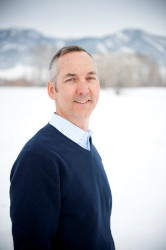
Doug Fletcher, co-author, How Clients Buy
“How Clients Buy was my first book, but hopefully not my last,” Fletcher said by email when asked about the book. “It’s been a wonderful experience. One of the highlights of my professional career.”
The hardcover book, published in 2018, is divided into 19 chapters and four main sections: The Problem, Obstacles, How Clients Buy and Putting the Seven Elements to Work.
“Doug and I believe that high end, highly customized expert services are sold to clients in very different ways than, say, an iPhone, which is sold on features, attributes, and price,” McMakin said. “Indeed, it is not even useful to think about selling services. A better paradigm is to think about ‘how clients buy.’ We concluded that most clients engage with would-be consultants by way of relationships, referrals, and reputation. The question that fascinated us, both solo practitioners and members of large consulting firms, is how one systematically drives those three R’s.”
“The trend toward fewer companies (which are larger and able to serve global markets) is fueling double-digit growth in the $1.7 trillion global professional services market as companies seek to outsource (either nearshoring or offshoring) non-core functions,” McMaking said to a question about how the offshoring of professional services jobs and the reduction in the number of publicly traded companies impact professional services in the United States. “Large companies face two challenges: they need to compete in a global war for top talent, and they need to remain agile to be able to pivot strategically as disruptive forces undermine markets and business models. By hiring just-in-time senior leadership in the form of a consulting or advisory contract, companies can sustain and build competitive advantage in a fast-moving, ever-changing marketplace.
The future for those who offer specialized insight born of sector specific experience is strong. In the course of our research, we were told by rainmakers that expert service practice areas are growing more global even as they are becoming more focused. A company no longer hires a local accountant to do all their work, but instead hires different accountants, who may be geographically disbursed to help them solve specific problems where they have world-class domain expertise.”

Tom McMakin, co-author, How Clients Buy
Marketers describe Generation Z as the most diverse generation in our country’s history. When asked in what ways, if any, they anticipate this will affect how and what clients buy, McMakin replied, “Just like the country is becoming more diverse, so too is the world of expert services. To succeed, professional service firms need to shrink the pond and narrowcast to specific groups of people where their experience and expertise most applies. This can be a step-up for bands of experts who might have found themselves left out of the corporate mainstream in the past. Not only can they speak to the advantage inherent to their diverse backgrounds – think consultants who rolled out of the Kenyan banking sector advising multinationals on east African trade – but true expertise, informed by a long set of relevant experiences and thoughtful reflection – floats free of the kind of constraints that have hindered diverse professionals in the past. At the same time, increased diversity in large companies is driving a thirst for more diverse input into those companies opening the door to groups of consultants with different and valuable points of view.”
Fletcher said, “With regard to Gen Z – one other point we make in the book is how clients buy today vs. how they might buy in the future. Today, generally speaking, decision makers in larger organizations are not Gen Z – or millennials. Today’s clients still prefer to hire people that they know, respect and trust or who come highly recommended by a colleague. Tomorrow’s leaders may be more willing to buy expert services more digitally – using online reviews, Skype, Zoom, and other digitally formed relationships. It’s hard to say. With today’s large expert services projects – often in the hundreds of ‘000s or millions $, these are purchased typically after long, face to face relationships are established. How clients buy ten or twenty years from now may be very different?”
McMakin is chief executive officer and partner of Profitable Ideas Exchange (PIE). Before joining PIE, he was a co-founder and managing director with Orchard Holdings Group, a private equity firm based in Cincinnati, Ohio.
Fletcher splits his time between teaching at Montana State University’s Jake Jabs, and speaking, writing, and coaching about business development in professional services and consulting. He serves on the board of directors of The Beacon Group in Portland, Maine.
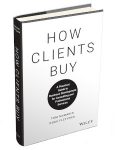
Click to buy How Clients Buy
Comments:
Filed Under: Books
Posted by Elena del Valle on June 6, 2019

Crack the Code
Photo: Somos
Louis Bezich, senior vice president of Strategic Alliances at Cooper University Health Care, is a passionate men’s health advocate. So much so that he dedicated four years to writing Crack the Code 10 Proven Secrets That Motivate Healthy Behavior and Inspire Fulfillment in Men Over 50 (Somos, $19.99), his first book. The 284-page softcover book, 100 percent self-financed, was published this year.
He hopes to motivate men over 50 to establish their own healthy lifestyles. He is already working on a follow up title on a topic he declined to disclose.
“The project involved concept development, initial focus groups, the national survey, interviews, probably a year or so of writing and editing, then post-writing development of the title, cover and other publication tasks,” he said by email when asked how long it took him to publish the book.
When asked why he wrote the book in 2019 he said, the combination of three factors inspired him to write the book: his personal experience, his belief that existing approaches to foster healthy behavior have failed, and his belief that the value-proposition is too strong to ignore.
“I discovered the power of motivation during my time as a single dad,” he said. “Exercise was my means of coping with the stress of raising two sons, pursuing a career and ensuring that I was fit so I would always be there for the boys. I witnessed first-hand the connection between happiness and healthiness. For me, what started as a coping mechanism as a twenty-something dad became a passion as a fifty-something man when the boys were off on their own.
When I became a health care executive, I was alarmed to learn that that only 3 percent of Americans lead a healthy lifestyle and 40 percent are considered obese. Even more concerning is that men over 50, my demographic, are the poster child for poor health practices; we refuse to see a doctor and have what experts call a health attention gap. All this in the context where our own behavior is by-far, the most significant influence on our health and we spend more on health that any other industrialized nation in the world. This represents a failure of our current systems and cry for a new unconventional approach.
Healthy behavior powered by social motivators is a win-win, personally, culturally and economically. As individuals we can improve our health and increase our happiness. As a society we have the ability to make a change with huge significance. And, from a health-care perspective, we can impact the need and ultimately the cost of care. (i.e., examples—seat belt use, smoking cessation, recycling). The case for healthy behavior is just too strong to ignore.”

Louis Bezich, author, Crack the Code
When asked who is the primary target audience for the book he explained he expects it will appeal most to men over 50 and the people that love them; their wives, partners, children and grandchildren. Additional audiences could include health care providers, insurers, policy makers and “anyone who has struggled with their health.”
The “10 Proven Secrets” mentioned in the book’s subtitle refer to his research on healthy behaving men 50 and over that included a survey of 1,000 men nationwide and 30 interviews. He believes his findings are consistent with the literature on behavioral health.
When asked to share advice with readers who struggle adopting healthy behaviors such as adjusting to changes, making new friendships and relationships he replied, “Before your purchase that gym membership, order the exercise equipment or start that new diet, build your personal motivational platform based around your social relationships following these three basic steps: Conduct Your Social Inventory. Think about what’s most important in your life. Really consider, I mean really think about what’s ahead in the years to come, and what you’d like to be doing this week, this month or this year with your wife, partner, children, grandchildren, your job, your volunteer work whatever. Think about the rest of your life; what’s ahead for you, and perhaps more importantly, what the future holds for the ones your love. Think about the joy of active participation, versus restricted or perhaps even no participation in their lives. When you’ve completed your inventory, think about how your aspirations match your current lifestyle and recognize the gaps.
Build Your Social Platform. Second, based on your inventory, and those gaps you’ve identified, build your personal social platform. The healthy men have clear social goals and robust calendars and activities that give them purpose and meaning, and most importantly, the motivation to stay healthy. Do the same and engage your loved ones in the process. It can actually be fun.
Third, work your strategy. Find your rhythm. The healthy men use routines, rituals and habits as guardrails of their behavior and are in a position to bounce back quickly if they are drawn off course. Rhythm feels good and provides a level discipline.”
With more than 40 years of executive experience, Bezich also serves as an adjunct professor in the Graduate Department of Public Policy Administration at Rutgers University. Bezich has published numerous articles in the field of public administration and health and is a contributing author to Corporate Lawbreaking and Interactive Compliance.

Click to buy Crack The Code
Comments:
Filed Under: Books
Posted by Elena del Valle on May 8, 2019

The Transparency Sale
Photos: Todd Caponi
Buyers want to know what the flaws are in a product. So much so that they favor bad reviews over good ones, according to Todd Caponi. He cares about sales methodology, learning theory and decision science. He is convinced that the key to sales success is transparency. In his first book, The Transparency Sale (Ideapress Publishing, $24.95) published last year, he seeks “to arm the modern seller with the knowledge, ideas, tools and actionable techniques to ready themselves for the future of sales; radical transparency.”
“The short answer is eighteen months, however, it’s not that simple,” Caponi said by email via his publicist when asked how many months or years the book required. “I first wrote about the idea for a publication back in May of 2017, and it went viral. The concept definitely resonated, so that signaled the beginning of the process. When you decide to write a book, the first step should always be to write a proposal, even if you’re intention is the self publish. It helps you vet out the likelihood of a successful book, and lays out your plan. I completed the proposal in November of 2017. The contract with my publisher, Ideapress, was signed in February of 2018, which kicked off the full-time writing process. The book officially launched in November of 2018.”
When asked whether is was his first book and what prompted him to write a new one book in an already crowded field he replied, “Yes, it is my first book, and yes, there are so many sales books out there. As a student of those books combined with years of experience as a seller and leader, I recognized a non-obvious evolution taking place in the world of sales. The proliferation of ratings, reviews and the accessibility of peer feedback is changing the way we buy. Beginning with Amazon’s launch in 1995, the idea of providing both positive and negative peer provided reviews appeared to help buyers predict what their experience will be following a purchase. In the twenty-four years since, reviews and feedback have permeated every meaningful purchase we make, from the products we buy, the experiences we select (restaurants, hotels, even Uber rides) and the apps we download. Buyers have come to rely on reviews and feedback, seeking reviews in 95 percent of their substantive purchases.
And, those reviews and feedback are no longer confined to just to B2C purchases. They are now inflating their way into the world of B2B, where a simple Google search allows buyers to easily review peer provided feedback on products through companies like G2Crowd, TrustRadius, and many others. Buyers can also peek inside the culture of the companies they’re considering making a purchase from through websites like Glassdoor.
Sellers have always been taught to sell perfection, that their product or service is perfect for the client. However due to this evolution, you can no longer hide your flaws and expect to get away with it. It must change the way we position and sell our products or services to build the trust necessary to end in a long-term successful outcome.”

Todd Caponi, author, The Transparency Sale
When asked about the title of the book he replied, “The Transparency Sale is about giving buyers all of the information their brain requires to feel confident in making a buying decision. It starts with a better understanding of our buying brain in how we make decisions as consumers. Beyond reviews, building a better understanding of how decision making really works is key to improving your ability to sell anything to anyone. It begins with transparency, in that leading with your product’s flaws, with authenticity and honesty, sells better than positioning perfection.”
The primary target audience for the book? “The concepts of this book, all the way down to the way we position, present and negotiate, are immediately applicable and actionable to anyone who’s role requires them to influence other people to do something different tomorrow than they are doing today. That is primary sales professionals, but the feedback from cross-functional executives, recruiters, realtors, financial planners and marketers has been amazing.”
When asked about the controversy surrounding fake reviews and review sites that sell ads he replied, “The push for sellers to encourage, or even pay for fake reviews is ultimately doing themselves a disservice. It may sound counter intuitive, but negative reviews sell better than positive ones: As mentioned above, 95 percent of consumers read reviews before making an unfamiliar purchase of substance, and that number is growing; 82 percent of consumers seek out negative reviews, and that number is growing as well, which leads to the fundamental statistic driving the need to change. Purchase likelihood peaks when a product whose reviews are in the 4.2 to 4.5 star range. A 4.2 sells better than a product with a perfect five-star rating!
Sellers that cram as many 5-star reviews are actually eroding the trust they’re buyers have in them. Buyers are smart. They seek out the negative reviews, which actually HELP the buyer make a purchase. It happens with reviews in B2C, but also when we, as sellers, present our solutions as perfect. We’re driving buyers to find the flaws themselves. Own the conversation, lead with the flaws, build trust, shorten sales cycles, win more often.
In other words, in this non-obvious evolution happening in the world of sales, not only is leading with your solution’s flaws a requirement given the proliferation of reviews and feedback on everything we do, buy and experience, as it turns out (backed by brain science), it is also the fastest path to lasting trust, so regardless of reviews, it’s the right thing to do, anyway, having magical impacts on your results.”
The 193-page hardcover book is divided into five sections and 14 chapters. The author is keynote speaker, workshop leader and trainer as well as principal and founder of Sales Melon LLC.

Click to buy The Transparency Sale
Comments:
Filed Under: Books
Posted by Elena del Valle on April 3, 2019

Si mi mama fuera ornitorrinco
Photos: Science Naturally
Seventeen years after the publication of If My Mom Were a Platypus Science Naturally published a Spanish translation of the children’s book. Si mi mama fuera ornitorrinco (Science Naturally, $12.95), the 64-page softcover title written by Dia L. Michels, translated by The Spanish Group and illustrated by Andrew Barthelmes is filled with color illustrations and journal style sketches of animal babies and their families on most pages.
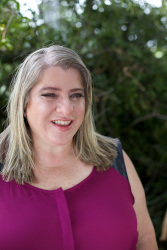
Author Dia Michels
“The inspiration for the book came out of pregnancy misery,” said Michels when asked how the book came about. “I was so excited about being pregnant and becoming a mother – but my joy was soon mollified by round-the-clock morning sickness, frightening nightmares, and general wretchedness. I started researching other mammals to see who did pregnancy better than humans. Long story short, I decided that, for the purposes of pregnancy and breastfeeding, nothing could be better than being a platypus. The only way I could survive being pregnant was to could channel my inner-platypus. This desire to know how other mammals reproduced continued past the birth of my daughter, and pretty soon, I knew enough about mammal birth and breastfeeding to create a book. Many years of research went into parsing down which mammals to include. All it all, it took about a dozen years from idea to publication.”
She explained the book is used most frequently in a classroom setting, suggesting it might make a good addition to a home library for nature-minded children or gift for mothers with new babies. It works well as a read aloud option for children ages six to eight and as an independent reading reference text for ages eight to twelve and above. The publisher released free downloadable Teacher’s Guides, with hands-on activities, in English and Spanish.
 Andrew Barthelmes, illustrator, Si mi mama fuera un ornitorrinco
Andrew Barthelmes, illustrator, Si mi mama fuera un ornitorrinco
“I love learning about patterns and oddities in the mammal world, from hippos being the only mammal whose eyesight is just as good above water as below, to lions being among the only mammals that will wet nurse,” Michels said regarding the weirdes random fact about the mammals in the book. “My favorite random fact is that hooded seals, who spend their lives swimming in arctic waters, will only breed, whelp, and breastfeed on land. Why is that weird? They live where there is no land. The only way the species can survive is by procreating on sea ice—and hoping it doesn’t melt before they’re done!”
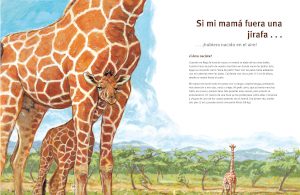
An inside page from the book
When asked how they are promoting the title Michels replied, “We are promoting this title at bilingual education conferences, parenting events, and STEM symposiums nationwide. We’ve also circulated a digital press release, advertised directly to our previous Spanish/bilingual customers, and reached out to those who bought the English edition of the book. We also sent an extensive pre-release mailing to libraries, media, and medical professionals. Additionally, we’ve partnered with literacy organizations, including First Book, to make the title available to students in Title I schools at a highly discounted price.”
The title reveals how fourteen mammals navigate the path from helpless infants to mature adults. It was designed for readers ages 10 to 14 and younger Read-Aloud listeners. The seals along the top of cover represent some of the awards it has won. The “NSTA Recommends” designation means it was endorsed by the National Science Teacher’s Association. The yellow seal is an award from Creative Child Magazine, a national publication for parents. The book was chosen by a panel of parents and educators for the Book of the Year award. The blue award is a Young Voices Foundation Seal of Approval, which honors books that inspire, mentor, and/or educate readers of all ages.
Comments:
Filed Under: Books
Posted by Elena del Valle on March 28, 2019

Wise Guy by Guy Kawasaki
Photo: Guy Kawasaki
In his newest title Guy Kawasaki, author of 14 books, shares the insights he has learned over his lifetime. Wise Guy Lessons from a Life (Portfolio, Penguin, $28), a 246-page hardcover book, was published this year. It is divided into 11 chapters and begins with the emigration of the author’s grandparents to Hawaii.
When asked how long the project took to complete he replied by email, “It depends on how you want to look at it. From the time I decided to write the book until it was on the shelf was about eighteen months, but it took me sixty-four years to accumulate the wisdom to write the book. So the answer is between eighteen months and sixty four years.” And to a question about the audience for the book, he replied, “The primary audience is anyone with $20.”
“My publisher used the traditional methods of PR, ad buys, distribution through a salesforce, and social media,” the author replied to a question about promotion. “I used social media to recruit testers and reviewers; I spoke about it anywhere that I could; and I tapped my relationships with influencers. In general, we left very few stones unturned.”
The book is written in chronological and topical order. Kawasaki explains at the beginning of the book that he believes wisdom isn’t linear or quick. Each chapter includes a story and a section of what the author considers the lesson or wisdom to be gained. It is easy to identify as it is marked with a shaka or Hawaiian surfing hand symbol.
“My main goal was to empower people by telling them stories and then explaining the significance and wisdom underlying each story,” he replied when asked why he wrote the book. “This is not to say that every story in the book is a success story. I discuss many of my mistakes because they are highly educational. I hope, at least, that people will make different mistakes than the ones I made.”
When asked whether people can learn from anyone’s experiences he replied, “People can absolutely learn from the experiences of others. Otherwise 90 percent of books are a waste of trees and time. Are those people saying that they can’t learn that they should wear seat belts without being in a car accident?”
When asked if he is planning another book he replied, “I’ve written fifteen books. When I finished the first one, I told myself that I didn’t have any more books in me. I’ve now done that fifteen times. I don’t find topics. Topics find me. When the next topic finds me, I’ll write it.”

Click to buy Wise Guy: Lessons from a Life
Comments:
Filed Under: Books
Posted by Elena del Valle on March 7, 2019

The Expanding News Desert Report
Photos: UNC Center for Innovation and Sustainability in Local Media
Many people believe balanced journalism provides us a sense of belonging to the place where we live and reinforces our trust in democracy. In the last decade it has become clear that newspapers and print media in general have had difficulty adapting their revenue model to the digital era. New generations seek news on social media and online via what have become the top online publishers, at least the ones with the highest revenue, leaving traditional media floundering in the winds of change. As a result in the United States increasingly our communities are losing access to local news. Cities and areas without local dailies or weeklies or with ghost versions of their former publications have been called news deserts.
In The Expanding News Desert (University of North Carolina Press, $12) Penelope Muse Abernathy, Knight chair in Journalism and Digital Media Economics University of North Carolina at Chapel Hill, discusses news deserts nationwide. The 102-page softcover book published in 2018 is divided into two main sections: The Loss of Local News: What it Means for Communities; and The Enduring Legacy of the New Media Barons: How Private Equity and Hedge Funds Changed Newspapers.
Since 2004 the United States has lost about 1,800 papers, including 60 dailies and 1,700 weeklies and California leads the nation in loss of dailies, while New York, Illinois and Texas lost the most weeklies, according to the book. Equally impactful to the rise of news deserts is the loss of readers. In the past 15 years, the book says, readers dropped to 73 million from 122 million. At the same time loss of competition has resulted in less coverage of local and state news, which studies have found often results in government inefficiency and increased costs, the book points out.

Penelope Abernathy, author, The Expanding News Desert Report
A troubling trend is the purchase of newspapers by investment companies who as a result become large and powerful controllers of news at a national scale. Their cost cutting and profit enhancing measures often have resulted in “ghost” papers, publications with too few resources to adequately cover their markets. The largest 25 companies of this ilk own 2, 198 papers. The largest of them is New Media/Gate House with 451 papers and a total circulation of 4.4 million. Others include Gannett with 216 papers, Digital First Media with 158, Adams Publishing Group with 144 and Community Newspaper Holdings, Inc. (CNHI) with 114.
The analysis in the book is based on information collected by the School of Media and Journalism at the University of North Carolina at Chapel Hill in the four years prior to the publication of the book. The researchers examined the status of more than 9,000 publications from data sourced from press association and governments as well as independent online research. It excludes the largest newspapers such as The New York Times, Wall Street Journal and USA Today as well as specialty publications. The book author invites readers to its partner website for local level specifics regarding news deserts.
Comments:
Filed Under: Books
Posted by Elena del Valle on February 27, 2019
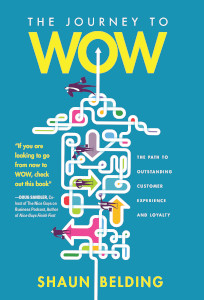
The Journey to Wow
Photos: Shaun Belding
Shaun Belding believes that when it comes to customer service the customer’s point of view is the only one that is important. Convinced it had been 25 years since anyone had written about the issues he set out to remedy the situation by authoring The Journey to Wow The Path to Outstanding Customer Experience and Loyalty (Koehlerbooks, $16.95) using a fictional company to illustrate the salient points.
“It was the right time for this kind of book,” he said when asked by email why he wrote the book now. “Customer experience is continuing to be a dominant factor in organizational success, so the topic is something that every company needs to be focused on.
The inspiration of the book came from two things: The first was that I saw a gap in the existing literature surrounding the topic. While there were a lot of very good books that touch on specific aspects of customer experience – convenience, effort, customer service, etc –there weren’t any that examined it as a comprehensive entity.
The second inspiration was that, since Ken Blanchard and Sheldon Bowles wrote Raving Fans 25 years ago, nobody has really presented customer experience from the perspective of the customer. It seems to me that, when push comes to shove, the customer’s is the only perspective that really matters, isn’t it? I found it a little odd that the one voice that matters, the customers’ voice, hadn’t really been heard for 25 years.”
His target audience? Anyone who is involved with customers and not just customer experience geeks, he said.
“Having said that, some of the core messages are directly targeted to people in executive leadership positions,” he said. “There is a direct relationship between a company’s ability to deliver consistent, sustainable customer experience, and how well a CEO truly understands the perspectives of his or her customers.”
Regarding loyalty the author said, “The best way to define loyalty is through the words of our customers. Loyalty is when a customer asks, ‘Why on earth would I want to do business with anyone else?’ – and then can’t think of a good answer.”
The 201-page softcover book published in 2018 has 26 chapters and an epilogue. It was written using a fictional narrative.
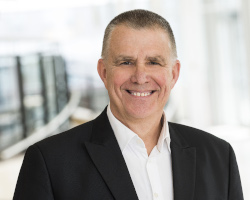
Shaun Belding, author, The Journey to Wow
When asked how long it took for the book to be published he replied, “I’m almost embarrassed to say. The Journey to WOW was a bit of a journey for me as well, as it took ten years to get it from start to finish. I had to squeeze the time out between trying to run a company and travelling around the world with my speaking engagements. Oh yeah – and trying to be a husband and father – I can’t forget about that.
On a positive note, the experience was a bit of a wake-up call for me. Toward the end, when I started re-reading it, I realized how many of the references that I had written in the early stages were already outdated. Nobody uses faxes or PDAs much anymore. I had to change those references.
I also realized that I had not initially included anything related to social media and smart phones – because those hadn’t yet begun to impact the business world in a big way. It was crazy that I had to update the book so much before it even got published. A big reminder of how fast our world is changing.”
When asked why he used a fictional company (Household Solutions) in the book he replied, “With Household Solutions (instead of an existing company) I was able to create a wonderful composite which allowed me to demonstrate many of the common challenges all companies face.
The most important issue I was able to illustrate was right at the beginning – an executive leadership team that had no idea how bad their customer experience was. And that, despite how bright and motivated they were, they still were failing to see how profoundly it was damaging their future. This level of unawareness is far more prevalent than almost everyone realizes. The fact that the iconic retailer Sears filed for Chapter 11 only two weeks after The Journey to WOW came out really punctuated that fact.
Even those companies that are trying to keep their fingers on the pulse of their customers are at risk, because most of the methodologies they are using aren’t giving them the real or whole story. This actually puts them at greater risk in some ways, because the Big Data convinces them that everything is okay, and they become complacent.
It also allowed me to highlight the impact of some common corporate practices that have a profound negative impact on customer loyalty. Things like companies that hide their telephone numbers, and make it impossible to have a conversation with a human. Executives that build walls around them so that they don’t have to talk with customers. Decisions that are focused more on customers’ wallets than on customers themselves.”
When asked: How can a company convince disinterested employees to offer outstanding customer service? He answered: “Fantastic question. And the answer really boils down to two things – leadership and support.
There are indeed some customer service employees who just don’t care. There are many more who do care but don’t know what to do. The question we need to ask is – why? How has this happened?
Far too many customer service employees aren’t set up for success from the moment they are hired. They aren’t given anywhere close to an adequate level of direction, appreciation, respect or tools to do their jobs well. It seems to me that this is more of an indictment of leadership than anything else.
Leaders need to have a clear and motivating purpose for their teams – something that gives their team a reason to care. They need to lead with passion. They need to ensure their team is trained (with professional training, not just a couple of YouTube videos to watch). They need to clearly articulate their expectations to each team member, and then provide relentless support to help them be successful.
Most companies want to deliver outstanding customer service, and most understand the tremendous value and ROI that comes with it. But most don’t know where to start. Most try to apply solutions before they truly understand what it’s like to be one of their own customers.
Not coincidentally, those companies that have succeeded are also the ones which have a strong and sustainable customer-focused culture. They understand that a culture of outstanding customer experience isn’t achieved by just telling employees to deliver better service. They know that delivering outstanding customer experience is a mission. It is in a company’s DNA. Most importantly, they know it’s not a destination – it’s a journey.”
Belding is chief executive officer of The Belding Group of Companies. The Journey to Wow was his sixth book. His first five were on how to navigate difficult people and achieve success in the workplace.
Comments:
Filed Under: Books
Posted by Elena del Valle on January 31, 2019

Conversation Marketing
Photos: Kevin Lund
Kevin Lund makes a living as a content marketer. He is convinced that while content marketing is not overly difficult it is a skill that needs to be developed. Believing he had know how to share with the world he spent a year conceptualizing, writing, editing and producing Conversation Marketing How to Be Relevant and Engage Your Customer by Speaking Human (Career Press, $16.95), a 230-page softcover book published in 2018.
“Any business, entrepreneur, marketing & communications professionals, content managers, and writers, who are interested in connecting with their own audiences, creating value for them, and ultimately monetizing that relationship,” he said by email via his publicist when asked about the target audience for the book.
“Companies and brands need to focus on eye-level conversation to create actionable content,” he said when asked about the term “speaking human” in the subtitle. “Speaking human implies using the same social mores that we employ in personal conversations with our peers – i.e. no jargon and having the ability to shape thoughts and inspire action through conversational story-telling.”
When asked: In this era of hacking, privacy concerns and identity theft how do you gain or regain your client’s trust? He said, “I’m not sure I have enough details to answer this question effectively. But broadly, there is a conversation happening around this subject that firms who are affected by this should be a part of. Educational articles to get in front of a potential problem are great ways to instill trust in an audience, particularly when they come from well-known brands.”
“All are effective with the right strategy,” he replied when asked: what are the most effect means and venues for communication, smartphones, tables, desktops, social media, email, online, print, broadcast? “It comes down to a smart channel strategy. The long sale process today can be through multiple touch points. Each of us have a unique preference for information gathering. Casting a wide net, but focusing on a majority of that strategy in the places where your audiences are hanging out the most is important.”
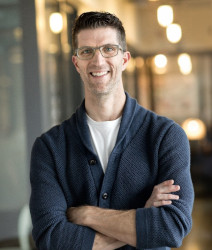
Kevin Lund, author, Conversation Marketing
“Email is still considered to be one of the most effective means for generating revenue and information-sharing for B2B and B2C firms,” he said when asked about the effectiveness of email marketing today. “Particularly when it comes to opt-in email campaigns. If a brand has a content strategy, using a blog or microsite, for example, using a lead-generation program that solicits signups for an email that is relevant to the person will have much higher open rates than unsolicited rates. The cost of creating information-based content in emails, like a newsletter or blog post, are nominal, and the ROI is very high.”
What is the best way to deal with market fragmentation? He said, “Fragmentation is a content marketer’s best friend! It’s all about relevancy, which is not the same thing as writing a couple of articles now and again that reach a smaller segment of your audience. It’s about creating multiple content strategies targeted to smaller groups of a larger audience. Go deep and niche. The more niche, the more”
So many companies talk, but don’t engage or respond, is that strategy advisable? His reply: “That’s a terrible idea. Complacency kills and content isn’t going away. Brands who don’t engage with content are putting themselves at a competitive disadvantage. Content marketing is about engagement using two-way conversation, not one-way conversations. If brands are just talking, nobody’s listening. There’s a right way and a wrong way to engage in conversation. Putting out trite content and hiding behind the language of “you” isn’t going to instill trust and win customers.”
The book is divided into three main parts titled Planning, Talking and Learning; and 10 chapters. Chapter titles are: Earn Attention, Tell A Story, Stay Humble, Pick Your Party, Be Relevant, Open Up and Listen, Start the Conversation, Known When to Stop Talking, Get Your Customer Involved and Ditch the Checklist. The author highlights Red Bull Media as “perhaps the world’s most successful content brand.” Lund is the founder and chief executive officer of T3Custom, a Seattle based content marketing agency.
Comments:
Filed Under: Books
Posted by Elena del Valle on January 17, 2019
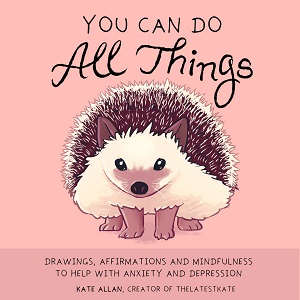
You Can Do All Things
Photos: Kate Allan
Has the New Year got you down? We all know someone who could use a pick me up. California artist Kate Allan does too. Many times drawing and being kind to herself helps her feel better. Her first book, You Can Do All Things (Mango, $22.99), is filled with 187 colorful drawings of animals and plants as well as words of encouragement for anyone suffering from anxiety and depression.
“I’m an artist and writer who has struggled with anxiety and depression for most of my life,” she said by email when asked about the book. “Both illnesses have set me back in a variety of ways; I learned to drive, had my first relationship, and got my degree later than my peers. So, I wanted to create a book of all the things I’ve learned along the way, everything that kept me going— whether it was calming myself through a small worry about not being good enough, to diffusing an intense preoccupation with suicide. The biggest lesson for me has been that self compassion and understanding will carry you through the worst of life, so most of the book’s messages are about validation, encouragement, and kindness.”
The 201-page hardcover book published in 2018 is made up mostly of color full page drawings in pages without page numbers, accompanied by short text. Examples of the inspirational messages include: “No one else knows what they’re doing either. It’s all going to turn out fine; No negativity today. You’re gettin’ work done! everything will work out, you’ll see.” In the conclusion she shares self help ideas such as creating something or de-cluttering.


Kate Allan drawings
“All of my book is written by someone who has been through the same struggles,” she said. “I argue my negative thoughts and turn those arguments into captions. Somehow it can feel more legitimate to hear something like, “you’re not failing, anxiety lies” coming from a sparkly purple cat rather than a person. Not sure why, but I’m rolling with it!
It’s all about challenging those insidious thoughts that bring us down, and I think that is the unfortunate commonality we share, no matter what gender or age.”
“I was a bit lucky that most of the book’s content had been created before my publisher Mango came along— I have always wanted to create a book of my writings and illustrations, and it was really just about waiting for the right opportunity,” she said regarding the publication timeline. “Mango contacted me in February 2018, and it was all put together by July.”
Regarding the artwork she said, “My process is that I sketch in pencil, looking at various reference photos online. Then I do the digital line work, coloring, and lettering in Paint Tool SAI and Photoshop.”
Her way of measuring success? “I just want the book to be helpful. I’ve created something that represents all the work I’ve done over the course of my life to succeed despite mental illness, and I hope that work will benefit others as well.”

Kate Allan, author, You Can Do All Things
Allan has been making a living as an artist for several years, partially through a shop where her artwork is sold, and partially through support by Patreon members. She is also the creator of the mental health art blog, The Latest Kate.
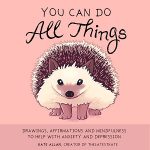
Click to buy You Can Do All Things
Comments:
Filed Under: Books












 Andrew Barthelmes, illustrator, Si mi mama fuera un ornitorrinco
Andrew Barthelmes, illustrator, Si mi mama fuera un ornitorrinco






















